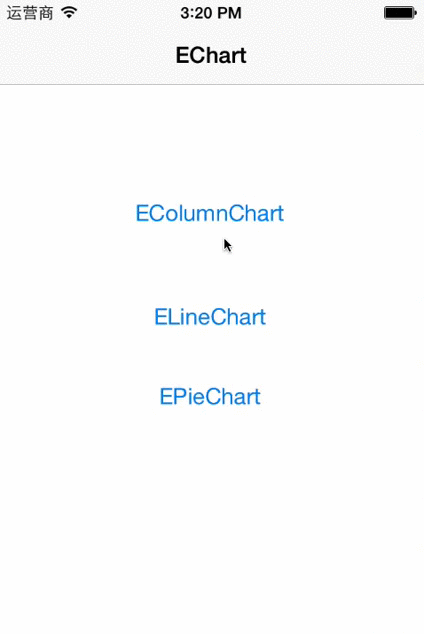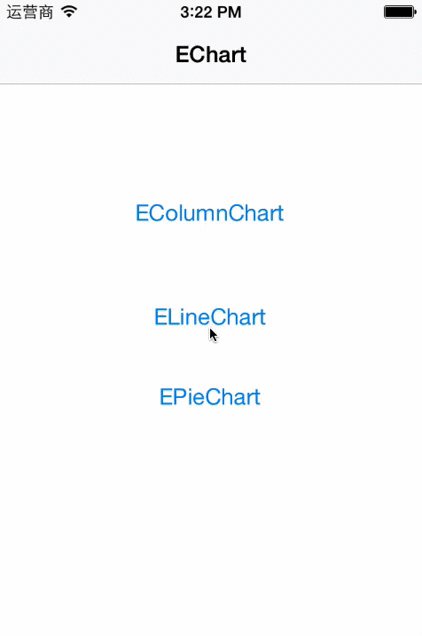Ecosyste.ms: Awesome
An open API service indexing awesome lists of open source software.
https://github.com/zhuhuihuihui/EChart
iOS/iPhone/iPad Chart, Graph. Event handling and animation supported.
https://github.com/zhuhuihuihui/EChart
Last synced: about 2 months ago
JSON representation
iOS/iPhone/iPad Chart, Graph. Event handling and animation supported.
- Host: GitHub
- URL: https://github.com/zhuhuihuihui/EChart
- Owner: zhuhuihuihui
- License: apache-2.0
- Created: 2013-12-11T09:57:56.000Z (over 10 years ago)
- Default Branch: master
- Last Pushed: 2016-08-08T03:48:31.000Z (almost 8 years ago)
- Last Synced: 2024-03-27T05:49:50.679Z (3 months ago)
- Language: Objective-C
- Homepage:
- Size: 165 KB
- Stars: 645
- Watchers: 25
- Forks: 117
- Open Issues: 15
-
Metadata Files:
- Readme: README.md
- License: LICENSE.md
Lists
- awesome-ios - EChart - iOS/iPhone/iPad Chart, Graph. Event handling and animation supported. (Charts)
- awesome-ios-ui - EChart - iOS/iPhone/iPad Chart, Graph. Event handling and animation supported. (UI)
- awesome-ios2 - EChart - iOS/iPhone/iPad Chart, Graph. Event handling and animation supported. (Charts / Other free courses)
- awesome-ios - EChart - iOS/iPhone/iPad Chart, Graph. Event handling and animation supported. (Charts / Other free courses)
- awesome-ios-star - EChart - iOS/iPhone/iPad Chart, Graph. Event handling and animation supported. (Charts)
- awesome-ios - EChart - iOS/iPhone/iPad Chart, Graph. Event handling and animation supported. (Charts / Getting Started)
- awesome-ios - EChart - iOS/iPhone/iPad Chart, Graph. Event handling and animation supported. (Charts / Other free courses)
- awesome-xamarin-forms - EChart - iOS/iPhone/iPad Chart, Graph. Event handling and animation supported. (Charts)
- awesome-ios - EChart - iOS/iPhone/iPad Chart, Graph. Event handling and animation supported. (Charts / Getting Started)
- awesome-ios - EChart - iOS/iPhone/iPad Chart, Graph. Event handling and animation supported. (Charts / Other free courses)
- awesome-iosx - EChart - iOS/iPhone/iPad Chart, Graph. Event handling and animation supported. (Charts)
- awesome-ios - EChart - iOS/iPhone/iPad Chart, Graph. Event handling and animation supported. (Charts / Getting Started)
- awesome-iosr - EChart - iOS/iPhone/iPad Chart, Graph. Event handling and animation supported. (Charts)
- learn.awesome.ios - EChart - iOS/iPhone/iPad Chart, Graph. Event handling and animation supported. (Charts / Getting Started)
- learn.awesome-iOS - EChart - iOS/iPhone/iPad Chart, Graph. Event handling and animation supported. (Charts)
- awesome-ios - EChart - iOS/iPhone/iPad Chart, Graph. Event handling and animation supported. (Charts / Getting Started)
README
#EChart
A highly **extendable**, easy to use chart with **event handling**, **animation** supported.
[](https://dl.dropboxusercontent.com/s/d2yxmmqa4yjigbu/eColumn.gif)
[](https://dl.dropboxusercontent.com/s/ehhscvf1m48v04h/eLine.gif)
[](https://dl.dropboxusercontent.com/s/2we5ay0fv5jmc6y/ePie.gif)
##Test
## How To Use
#### Download and run the [EChartDemo](https://github.com/zhuhuihuihui/EChart/archive/master.zip) project is the best practice to know how to use EChart.
### Step 1: Add EChart to Your Project
use [CocoaPods](http://cocoapods.org/) with **Podfile**:
```ruby
platform :ios, '7.0'
pod "EChart"
```
or Download project [here](https://github.com/zhuhuihuihui/EChart)
And Drag `/EChart/` folder into your project
### Step 2: Include ECharts in your View Controller
**EColumnChart** as a example, all ECharts work in a similar way.
Import the head file:
#import "EColumnChart.h"
Make your ViewController adopts the EColumnChart's protocol:
@interface YourViewController : UIViewController
Declare a EColumnChart instance:
@property (strong, nonatomic) EColumnChart *eColumnChart;
### Step 3
Give your EColumnChart a nice frame:
_eColumnChart = [[EColumnChart alloc] initWithFrame:CGRectMake(40, 100, 250, 200)];
Set EColumnChart's delegate and dataSource to your ViewController:
[_eColumnChart setDelegate:self];
[_eColumnChart setDataSource:self];
Add EColumnChart to wherever you want:
[self.view addSubview:_eColumnChart];
## Provide data & Get events
After setting up your EColumnChart, you may need to provide the data for the EColumnChart and you will be able to get events from EColumnChart as well.
If you were a expert with `UITableView`, you will be quite familiar with the way `EColumnChart` works. Because they work in a same way.
### DataSource
You need to implement every method in the `EColumnChartDataSource`
/** How many Columns are there in total.*/
- (NSInteger) numberOfColumnsInEColumnChart:(EColumnChart *) eColumnChart;
/** How many Columns should be presented on the screen each time*/
- (NSInteger) numberOfColumnsPresentedEveryTime:(EColumnChart *) eColumnChart;
/** The highest value among the whole chart*/
- (EColumnDataModel *) highestValueEColumnChart:(EColumnChart *) eColumnChart;
/** Value for each column*/
- (EColumnDataModel *) eColumnChart:(EColumnChart *) eColumnChart
valueForIndex:(NSInteger)index;
### EColumnChartDelegate
The implementation of the Delegate is according to your needs
/** When finger single taped the column*/
- (void) eColumnChart:(EColumnChart *) eColumnChart
didSelectColumn:(EColumn *) eColumn;
/** When finger enter specific column, this is dif from tap*/
- (void) eColumnChart:(EColumnChart *) eColumnChart
fingerDidEnterColumn:(EColumn *) eColumn;
/** When finger leaves certain column, will tell you which column you are leaving*/
- (void) eColumnChart:(EColumnChart *) eColumnChart
fingerDidLeaveColumn:(EColumn *) eColumn;
/** When finger leaves wherever in the chart, will trigger both if finger is leaving from a column */
- (void) fingerDidLeaveEColumnChart:(EColumnChart *)eColumnChart;
#License
EChart is available under the Apache License. See the LICENSE file for more info..